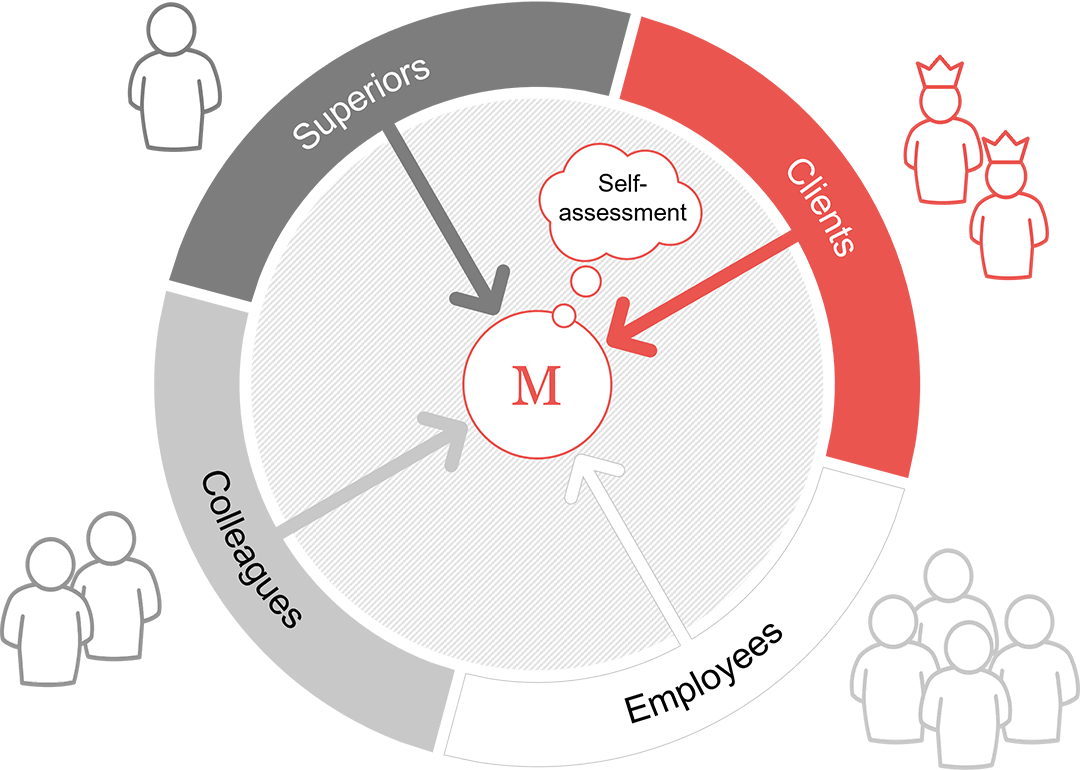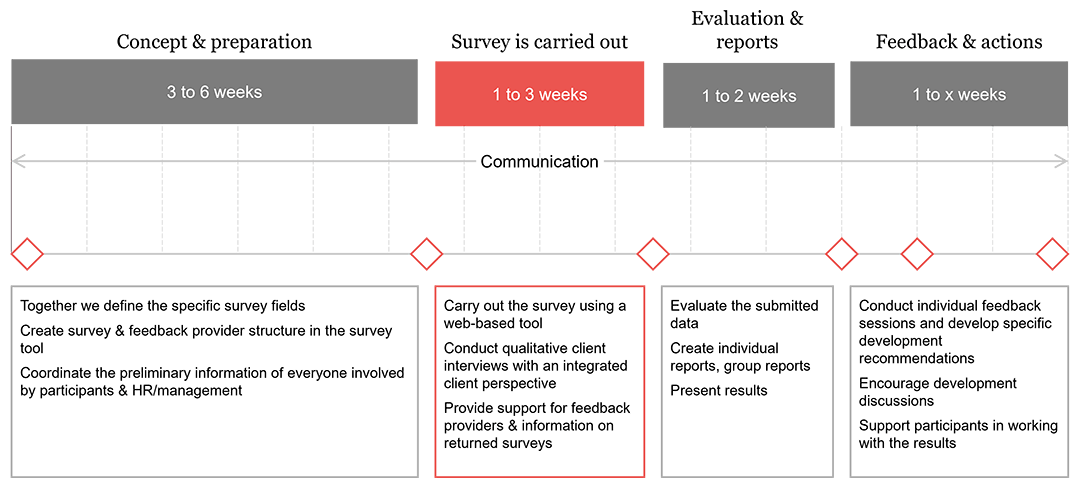360° Feedback for Leadership
- Are our leadership principles already being practiced in real life? To what extent do employees feel supported and that their competencies are recognised in their day-to-day work?
- How are managers and project leaders perceived by their most important stakeholders and cooperation partners? How can we continue to develop our feedback and corporate culture?
- What do we need to pay particular attention to in order to ensure that feedback providers have the confidence to give feedback in a way that is helpful to the feedback recipients? In the design, communication and implementation phases?
- Which process enables multi-perspective feedback (180°/270°/360° feedback) to develop its full potential?
In 180°/270°/360° feedback, we ask employees, superiors, colleagues and, if applicable, clients about relevant behavioral aspects of an executive, project manager, employee in a particular role. The wide range of perspectives enables particularly comprehensive insights for the feedback recipients into their behavior and how they are perceived by others.

Fig.: Feedback providers in 360° feedback: if superiors and employees are feedback providers, it is known as 180° feedback, if colleagues are included, 270° feedback, and with the client perspective we come full circle to 360°.
The illustration shows a feedback model visualized in the form of a circle. At the center is the leader (M), who undergoes self-assessment. The circle is divided into four segments, each representing different perspectives from which feedback is provided:
- Feedback from the superior(s) of the leader.
- Feedback from the employees who report to the leader.
- Feedback from colleagues who are on the same hierarchical level as the leader.
- Feedback from clients who interact with the leader.
The leader (M) receives feedback from all four perspectives. Furthermore, the self-assessment offers the perspective of the leader themselves. If only superiors and employees are included as feedback providers, it is referred to as 180° feedback. When colleagues are added, it is called 270° feedback. The inclusion of the client perspective completes the feedback to 360° feedback.
We successfully use three types of 360° feedback processes:
- Qantitative: Web-based survey that provides feedback on manager from many people in a very short time
- Qualitative: Selected individuals provide detailed feedback on the observable behavior of a manager and the impression he or she makes on others in a confidential face-to-face interview.
- Integrated: Quantitative and qualitative methods are combined.
360° feedback is a development tool,
- which provides valuable feedback on perceived competencies and the impression one makes on others.
- whose results are the basis for promoting more effective collaboration.
- whose aggregated results can provide HR management with insight into existing competencies in the company and valuable input for planning development measures.
- which makes information about optimisation potential at internal interfaces or along the entire service chain visible.
- whose successful implementation contributes to the further development of an open and trusting leadership/corporate culture.
At the same time, it is also a significant intervention, which needs to be taken into consideration during preparation, communication, and careful implementation in order to define expectations and address them in follow-up processes.
Approach

Fig.: Implementation of 360° Feedback
1. Concept & Preparation (3 to 6 weeks):
In this phase, specific survey fields are defined collaboratively.
The structure of the survey and the feedback providers are established in the survey tool.
Preliminary information is coordinated among all participants, including participants and HR/management.
2. Conducting the Survey (1 to 3 weeks):
The survey is conducted using a web-based tool.
If the client perspective is integrated, qualitative client interviews are conducted.
Support is provided to the feedback providers, and information about the feedback response is made available.
3. Evaluation & Reports (1 to 2 weeks):
The entered data is evaluated.
Individual and group reports are created.
The results are presented.
4. Feedback & Actions (1 to x weeks):
Individual feedback sessions are held, and specific development recommendations are developed.
Development discussions are encouraged.
Participants are supported in working with the results.
The survey
The survey is the first milestone in a longer process in which trust, communication skills and, not least, personal impact play a key role.
1. Content-related questions:
Based on existing systems (competence matrix, evaluation systems, values, mission statement, leadership principles ...), what specific feedback should be given?
2. Formal questions
Who should be the feedback recipients? How many feedback providers should be interviewed in addition to the senior manager from the individual feedback provider groups?
3. Evaluation and feedback of results
- Who evaluates the results and gives them to the feedback recipients?
- How are confidentiality and objectivity guaranteed?
- How should we structure the feedback of results to both feedback recipients and feedback providers (e.g., personal feedback meetings, written feedback of results, discussion of results by telephone, group workshops, etc.)?
4. Acceptance
In order to achieve the greatest possible degree of acceptance by both feedback recipients and feedback providers, the following aspects are also important:
- Voluntary vs. mandatory: Is 360° feedback carried out on a voluntary or mandatory basis for managers and/or feedback providers?
- Anonymity vs. non-anonymity: Do the feedback providers provide their assessments anonymously or not? Who evaluates the results?
- Sustainability of the method: How is the effectiveness monitored or the method evaluated? Who ensures that development measures are defined and initiated following the feedback of results?
Here, too, we offer support for dealing with the results in the team in a constructive and solution-oriented manner.
